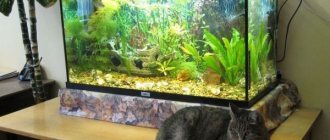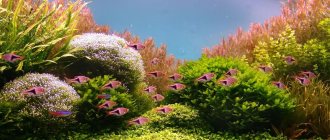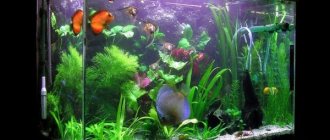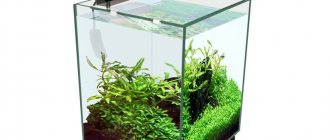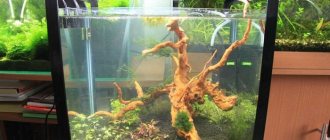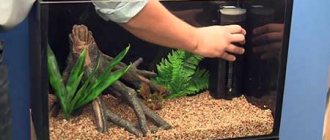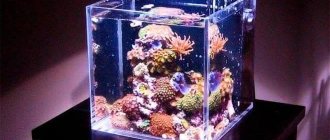A 50-liter aquarium is often purchased by beginners who are afraid of the difficulties of caring for a nano-aquarium and do not want to occupy the living space of an apartment with an overly large tank. A 50-liter aquarium, unlike smaller tanks, allows the use of internal equipment that greatly facilitates its care. In addition, it can be populated with more inhabitants of various species and larger plants can be planted. At the same time, such a reservoir, unlike larger containers, does not require much space for installation and cleaning it takes less time.
Choosing an aquarium
The size of a 50 liter aquarium can vary and depends on its configuration. You can find artificial ponds of various shapes on sale. The best option is considered to be rectangular, horizontally oriented containers with straight walls. Their dimensions are usually 51x27x35 cm. It is most convenient to place the necessary equipment in such tanks. In addition, they are best suited for observing the inhabitants, since straight glass does not distort the picture, and the simplicity of the form does not distract attention from the internal contents.
Another option for a horizontal aquarium is a panoramic pond with a curved front glass. It may fit well into the interior of the room, but observing the fish will be difficult due to the distortion of their appearance. In addition, such tanks take up more space than models with straight walls.
50-liter aquariums are also available in corner models. Such tanks look good in small spaces, but it is difficult to place all the necessary equipment and clean them.
On a note! In addition to the listed options, you can also find containers of other shapes on sale - moon-shaped, spherical, in the form of a vertical octagon, etc. Such reservoirs are inconvenient to maintain and are poorly suited for keeping fish.
Think about the future
Most of the fish you buy in the future will grow, change behavior or even change color. Therefore, you must know exactly what the cute little fish will turn into over time, and whether there will be enough space for it.
Do not buy fish that will outgrow your aquarium, even if you are sure that this aquarium is temporary and you will definitely buy a larger one. Looking to the future will also help you pay attention to species that you don't find attractive.
For example, the iris in adolescence is a nondescript fish. But when they grow up, they are bright and very beautiful fish that decorate any aquarium.
Necessary equipment
To maintain the artificial ecosystem in a stable condition and the comfortable existence of aquatic organisms, a 50-liter aquarium must be equipped with appropriate equipment. The equipment package purchased along with the tank must include the following components:
- Compressor. This device serves to supply air to the reservoir and saturate the water with oxygen. It is installed outside the aquarium and is connected via a flexible hose to a sprayer, which is placed on the bottom of the tank. It is important to position the device so that water does not fall on it.
- Filter. It performs the function of purifying water from mechanical dirt and harmful substances. The dimensions of a 50-liter aquarium usually allow the installation of an internal filter, but this device can also be external; in this case, it does not take up space inside the reservoir. It must have appropriate power, recommended for such a volume is 300 l/h. Some filters have a built-in aeration function, which eliminates the need to install a compressor in the aquarium.
- Heater. This device is necessary to maintain the water temperature at a constant level. It must be equipped with a thermostat. In this case, the device will automatically turn on when the temperature drops and turn off when the water is sufficiently heated.
- Thermometer. It is needed to control the water temperature. Aquarium thermometers are usually installed inside the reservoir - placed on the bottom or hung on the wall. Liquid crystal models are designed for gluing to glass from the outside.
- Illuminated lid. The aquarium must be tightly closed with a lid. It will not allow overly active fish to jump out of the water. The lamp can be built into the cover or installed separately. To illuminate an artificial pond, it is recommended to use fluorescent or LED lamps. Their power is selected based on the needs of fish and plants.
Rating of aquarium fish
The rating was created based on the opinions of experts who provided independent assessments. Reviews from real people who kept this or that breed for several years were also taken into account. The testing helped to identify the positive and negative qualities of the nominees, as well as the features of their content. When selecting fish for the TOP, the following criteria were taken into account:
- Size;
- View;
- Color;
- Care;
- Reproduction;
- Lifespan;
- Content temperature;
- Compatible with other types.
The price in this rating did not matter, since all types of individuals presented are relatively inexpensive. The reviews cover only the best aquarium fish that have become popular in 2021.
The best online pet stores
Decor
The procedure for decorating a 50-liter aquarium can be approached creatively, since such a volume allows you to create an interesting aqua design using decorations and live plants. The design of the aquarium should be attractive and original, but not too overloaded, otherwise it will distract attention from the inhabitants of the artificial reservoir.
To visually increase the volume of the aquarium, a background film with an image of the underwater world is glued to the back wall from the outside. Soil is placed at the bottom of the tank; for reservoirs with a large number of plants, nutrient mixtures are required. Decorations are placed in the corners and in the center of the container - driftwood, stones and all kinds of artificial figures. Plants are planted along the back and side walls. The foreground is left free: in this case, it will be more convenient to watch the fish and feed them, as well as clean up.
The best black aquarium fish
Black aquarium fish look very contrasting in artificial reservoirs and can visually dilute a very motley team. This species of individuals is quite diverse; there are large and small representatives, distinguishable by character and activity. This section presents the two most common types of black fish, which were selected by users.
Black swordtail
Black swordtails are very picky about their maintenance. They feed on live and plant food and love thick algae and brackish water. In general, these are friendly neighbors, but users recommend keeping two or three females per male to avoid conflicts. Reproduction in swordtails is quite simple. During spawning, it is enough to place the female in a separate container with dense vegetation on the bottom and surface of the water so that the fry can hide from the mother. In good conditions, individuals grow up to 15 centimeters, living up to 10 years.
Advantages
- They quickly reach sexual maturity;
- Easy to maintain;
- Clean the walls of algae;
- Doesn't require much space.
Flaws
- It is necessary to monitor the quality of feed;
- Requires frequent feeding.
It is noteworthy that if you keep only swordtails in an aquarium, then all the food that they have not consumed must be quickly removed from the water, since it will settle to the bottom and spoil the environment.
Ancistrus
Ancistrus have a very unusual appearance. Their mouth is shaped like a suction cup, making it easy for the fish to clean small plant formations on the walls of the aquarium. Ancistrus reach ten centimeters in length. Users highly recommend having a natural large piece of driftwood in the aquarium for them to hide behind and eat. These fish also need protein. Reproduction of this species is quite simple; during spawning, it is necessary to place the male and female in a separate reservoir, where the ancistrus will lay eggs in long tubular decorations. After spawning, the female must be removed, since only the male will care for the offspring.
Advantages
- Omnivorous;
- They live long;
- They have beautiful and varied colors;
- Does not require frequent feeding.
Flaws
- May offend scaleless fish;
- They need a large aquarium.
It’s okay if users forget to feed the ancistrus; these individuals can survive for several days on pasture. However, the diet should not be monotonous, since these home aquarium fish can simply dry out.
Plants
Live aquarium plants serve as a design element and also play the role of shelters for the inhabitants of the reservoir. They enrich water with oxygen and purify it of harmful organic compounds. The following types are suitable for a 50-liter aquarium:
- Java moss;
- riccia;
- Anubias;
- hornwort;
- elodea;
- cryptocoryne;
- Vallisneria.
Java moss.
Riccia.
Anubias.
Hornwort.
Elodea.
Cryptocoryne.
Vallisneria.
What to look for when buying fish?
Before choosing fish for the aquarium, you need to carefully examine them. Fish offered for sale in the store must be kept in a sufficiently spacious aquarium with clean and clear water, equipped with all necessary devices. The fish should be vigorous, brightly colored and free from external defects. Take a good look at the fins - in a healthy fish they should be smooth, not torn, and without signs of any disease. It is preferable to purchase young fish, since if you buy an adult fish, due to inexperience, you can buy a too old individual that will not live in your aquarium for very long.
You need to buy fish only where the conditions for their holding are fully observed. Under no circumstances should you purchase aquarium fish from traders at spontaneous markets, because very often such fish are sold in cramped aquariums with muddy water, which may contain microorganisms dangerous to aquatic life. If you bring home a sick fish from a dirty, unkempt aquarium, you risk introducing infection into your aquarium.
When buying fish, pay attention to their behavior. Each individual must behave as all members of the species usually behave. If the fish swims too chaotically, makes sudden movements, looks sluggish and exhausted, never buy such a specimen, because the fish may be sick and pose a threat to other inhabitants of the aquarium.
How many and what kind of fish can you keep in a 50 liter aquarium?
Fish for a 50-liter aquarium should be small and non-aggressive. This volume makes it possible to keep several small flocks of species of similar size and temperament. The following fish can be stocked in a 50-liter tank:
- Mollies. These are mobile, viviparous fish of medium size. They can be kept in a flock of 6-10 individuals. The most common color is black, but there are morphs of other colors: silver, white, golden and spotted.
- Som corridors. This is a peace-loving bottom fish. It feeds by collecting food from the surface of the ground, so its particles must be smooth so as not to injure the mouth and antennae of the catfish. Corydoras are kept in a 50-liter volume in a flock of 3-5 pieces.
- Gold fish. This is a popular type of aquarium fish, represented by many breeds. The species loves large volumes, so a 50-liter tank is suitable for keeping only 1 individual. A goldfish pond must be equipped with a powerful filter.
- Danio. These are small, peace-loving schooling fish. In a reservoir, they stay in the upper layers of water, near its surface. They are kept in groups of 10.
- Cardinals. These are fish colored predominantly in red tones. They prefer to stay in the upper and middle layers of water. They can be kept in a flock of 10 individuals.
- Guppy. This species has gained the greatest popularity among beginner aquarists. Guppies are small, viviparous fish with bright colors; Breeders have developed many morphs of this species. They are kept in a group of 20.
- Labeo. These fish are characterized by intraspecific aggression, so they can only be kept alone. However, they are highly compatible with other non-aggressive species of similar size. Labeos are mobile and brightly colored, due to which they attract the attention of the observer.
- Barbs. These are lively, bright, medium-sized fish. They are not shy and always remain visible even in a pond densely planted with plants. They can be kept in a group of 3-5 pieces, depending on the type.
- Gourami. These are calm, non-aggressive fish. They use atmospheric air to breathe, so an aquarium with them does not need to be equipped with a compressor. Depending on the type and size, 5 to 10 gourami can be placed in a 50 liter volume.
- Neons. These are small, bright, schooling fish. They are quite picky about the quality of feed and water and do not like temperature fluctuations. They are kept in a group of 20 pieces.
Dimensions of small reservoirs and their purpose
Even the smallest fish aquarium should be equipped with the necessary devices:
- filter;
- aerator;
- heater;
- lighting.
The advantages of small tanks include the following:
- compactness;
- easy care;
- convenient transportation.
Editorial: Cichlazoma severum
However, miniature reservoirs also have disadvantages. First of all, due to the small volumes, it is impossible to contain many inhabitants in the vessel. Secondly, the water in small aquariums gets dirty faster, so you will have to carefully monitor cleanliness and order. In tanks with a large volume, water changes are not as noticeable as in tiny ones, where any changes in environmental parameters lead to stress for the fish.
Small aquariums are divided into four types:
- Up to 5 l – suitable for interior decoration and planting. For example, only one tiny phenotype can be placed in a 2-liter aquarium, but experts recommend keeping such an aquarium without fish, because living in a cramped space makes pets feel discomfort. In addition, it is impossible to install equipment in such miniature reservoirs, so an aquarium without fish would be a humane solution.
- From 5 liters to 10 liters - a tank with such a displacement is also not entirely suitable for keeping living creatures. Of course, you can populate a tank with a school of zebrafish - the phenotype requires only one liter of water per individual, but you should remember about frequent cleaning, installation of equipment, without which the fish will die, and constant monitoring of water parameters. Therefore, experts also recommend keeping such an aquarium without fish.
- From 10 liters to 20 liters - in a reservoir of 10 liters or more you can easily place the necessary equipment and purchase beautiful and colorful fish, as well as plant lush and unpretentious green vegetation.
- From 20 liters to 50 liters - in an aquarium with such a displacement you can give free rein to your imagination, and have medium-sized fish, arrange instruments and decorations, creating underwater depths.
Starting an aquarium
Before starting a 50-liter aquarium, you need to decide on its design. The soil and decorations are washed before placing in the tank to remove dirt and harmful microorganisms. It is recommended to prepare the water in advance: before filling the volume, it must be left for at least a day.
The prepared soil and decorations are placed in the aquarium and filled halfway with settled water. Then the equipment is placed. After this, the volume is completely filled with water and the equipment is turned on. The pond is kept in this mode for a week. Then they check the water parameters using test strips and, if they are within normal limits, plant the plants and release the first inhabitants. These can be unpretentious snails and fish, for example, guppies. After another 1-2 weeks, after complete establishment of biological balance, the remaining inhabitants are resettled.
Catfish
Catfish are an excellent option for a novice aquarist who is deciding which fish are the most unpretentious and the best. Catfish are called orderlies or cleaners, since the fish feed at the bottom of the tank, where the fish eat the remaining food, preventing the food from decomposing. For beginning aquarists, two varieties of catfish are of interest:
- Speckled Corydoras are armored catfish with cute antennae. Despite their miniature size, corydoras look great in an aquarium - it’s especially fascinating to see a catfish looking for food at the bottom.
- Ancistrus - grows up to 15 cm in length. Using a suction cup mouth, catfish clean surfaces of algal growth and other organisms, helping the owner maintain cleanliness. In the absence of such food, ancistrus are fed with plant food and catfish tablets.
Care
Caring for a 50-liter aquarium is quite simple and does not take much time. Weekly care consists of replacing 1/3 of the volume with fresh water, cleaning the glass from plaque and removing excess organic matter from the soil surface. General cleaning of a 50-liter aquarium is carried out once every 1-2 months. During this process, the substrate is deeply cleaned with a siphon, the decorations are cleaned, and overgrown plants are trimmed and thinned out. The fish are not transplanted during harvesting.
A 50 liter aquarium is a good choice for a beginner aquarist. In this volume you can keep various small inhabitants and most types of plants. The dimensions of the 50-liter tank allow you to decorate it beautifully, matching the design to the interior of the room. Caring for it is not as difficult as for smaller reservoirs, and it takes up little space in the apartment.
If you liked the article or have something to add, leave your comments.
Read about fish before buying
Unfortunately, beginners are often lied to and sold incompatible species, either fish that are not suitable for beginners, or very large species. Sellers are not conscientious and in order not to become a victim of deception, you need to prepare.
Choose several types of fish that you like, you can look at them in pet stores or at the market. And carefully study the information about it, fortunately now there is the Internet. This will give you a lot of experience and an understanding of whether this particular fish is right for you.
The main questions are the size to which the fish grows, character, requirements for water parameters, and how to stay - alone, in pairs or in schools?
